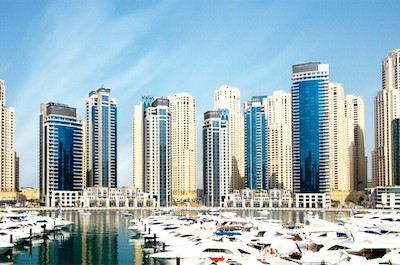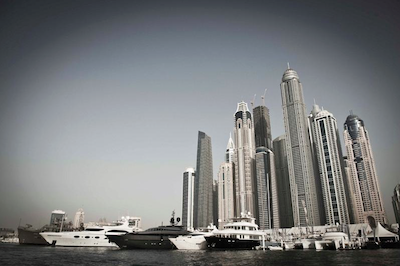The Middle East has emerged as a strong market for private aviation, according to a new report by Wealth-X and WINGX Advance.
The typical private jet owner in the Middle East is younger than global jet owners and, despite an average net-worth of more than $500 million less, has planes an average of three times as expensive, near $50 million compared to the average global owner’s $16.4 million. The numbers show not only that private aviation is a viable market in the Middle East, but other high-priced luxury offerings could also find a home.
The Middle East market has a good long term prospect, given: strong economic growth potential, particularly to the extent that Gulf states can develop non-oil sector; long distances between trading hubs, with alternative transportation inadequate; and infrastructure limitations, both in physical and human resources, which will be addressed over time," said Richard Koe, managing director at WINGX Advance. "In the short term the prospects are cloudier, due to regional conflict, poor infrastructure, and for now, economic impact of low oil prices."
“Private Aviation in the Middle East: Owner Profile, Trends and Business Opportunity” looks at the demographics of Middle Eastern jet owners compared to global jet owners and the flight trends of the private aircrafts.
Up, up and away
Private jet ownership is pretty much exclusive to ultra-high-net-worth individuals with tens of millions, if not more, in assets. Although North America continues to dominate the industry, that share has gradually dropped over the past twenty years.
According to the report, there are 211,275 UHNW individuals in the world, with an average net-worth of about $140.5 million; among Middle Eastern UHNW individuals, the number is noticeably higher, crossing $166 million.

VistaJet's Challenger 605
That Middle Eastern jet owners have a lower net-worth than global jet owners despite UHNW Middle Easterners being worth more, on average, than UHNWs elsewhere. This means that the individuals who stand out even amongst UHNWs have not been reached.
Given that the average liquidity of the Middle Eastern jet owner is around one-third of his net-worth compared to about 12 percent for global jet owners means many of these consumers may be accessible.
Almost 30 percent of Middle Eastern jet owners are involved either in industrial conglomerates with another 25 percent being in non-profit and social organizations. The same two industries make up barely 10 percent of global jet owners, whose field of work is more diverse with around one-fifth working in finances, the most popular field.

Dubai Marina
As the report notes, this is a reflection of royal family members – 70 percent of Middle Eastern jet owners inherit at least some of their wealth, compared to only a quarter globally – and economies being driven through infrastructure improvements and energy.
Middle Eastern jet owners are increasingly visiting Europe, perhaps due to ties to school or family or to escape summer heat, with a 21 percent year-on-year increase in September and an increase of 8.6 percent in 2014. Turkey, the United Kingdom, France, Greece and Italy are the top destinations.

Feadship yachts in Dubai
The traditional destination pattern is very predictable and gives a lot of guidance to luxury brands looking to market to this clientele; for example, FBO lounge advertising pinpointing precisely the arrival of customers from cities in the Middle East," Mr. Koe said.
As the Middle East continues to accrue wealth, and if private aviators tap into more of the region’s UHNW community, it could have a large impact on luxury sales in Europe. While Middle Eastern tourists will not have the same impact on the global luxury market as the much larger Chinese population has, it nonetheless presents opportunities for luxury brands to market extremely high-end products.
Additionally, Turkey is already seen as an emerging luxury hub. The country is positioned in the middle of Middle East, Asia and Europe, so brands working to do business should ensure they are also equipped to sell to a potentially diverse range of tourists.
Tourist town
Other sectors have already begun entering the Middle East, determining it to be a viable market for short- and long-term growth.
For example, last month British accessories label Anya Hindmarch entered a franchise agreement with Etoile Group to establish a retail footprint in the Middle East.
Anya Hindmarch’s terms with Etoile Group will see the establishment of stores and concessions in the Middle East, beginning in Abu Dhabi, United Arab Emirates. When entering into an unfamiliar market, it is helpful and important for brands to partner with a local entity that has an understanding of the culture and consumer sentiment (see story).
Recent financial reports have shown that planning for tourists and determining where they are likely to visit and why should be a key endeavor of brands hoping to build successful and repeatable strategies in the future.
For example, high sales in Western Europe and Japan led to decent third quarter results for Kering, suggesting strong business from Chinese tourists.
The Kering Group saw luxury sales increase by 14 percent on a reported basis and slightly more than 3 percent on a comparable basis in the third quarter of 2015 compared to the year-ago. Much of this improvement can be attributed to a variety of economic factors taking Chinese consumers to Western Europe and Japan, where Kering’s presence is relatively strong (see story).
Once again, understanding the reasons behind consumers' behaviors is key.
"Preference for large aircraft is not just a simplistic reflection of prestige, but one of practicality, since trips tend to be predominantly family oriented, with close and extended family members expected to accompany the patriarch," it states. "Typically, personalized VIP commercial airline interiors serve the families’ hierarchal traditions well, matching closely the rituals of daily life, including a heritage of eating together."
At the same time, brands should be aware of short-term risks and crucial differences of the sector in the Middle East compared to other regions.
"It's a fairly shallow market, with its core in Saudi and UAE, so it´s prone to volatility in these regions," Mr. Koe said. It's also predictably seasonal – both in terms of monthly activity levels and routes flown. The customer base is very inter-connected, so embedded suppliers to well and for others there is a high barrier to entry.
"To a different extent than in Europe, business aviation in Middle East is private and has an important luxury component, although it is used primarily for lifestyle rather than just showing off," he said. "So it´s closer to the luxury yacht industry for example than in Europe."
Final Take
Forrest Cardamenis, editorial assistant on Luxury Daily, New York
{"ct":"O7XBXNGq+d5T+Bi\/f1qHiFgUi\/6UTnzqSy4bMBQD49d\/52M6MTAJeeERPxQks0RUuMNP+2FR5yR\/vsYcGvrcDZekHrVTP3ue6XstHx\/+SOOVIVZMQFNqsYoR9rAl3cz91p7qc6IIq1qT421nrfn6u9ddgzOfrk3cuyJ\/fEE+G1nWOiJsY0buj2c+5pk+EZjVrBOa9iXW+G6lkipxW9qsOF39HT9cwrZFZFO2mipno+Jp8MCKU9PcApefhFg19uPj8fx0YKS8LclHKffXN4FPeaKQjS\/WA54O0P7Ic1\/HrwMh\/6xc6xSluc8WcoOQx5YFNaJ+Jp3V2vZUo2dZm6nVdAafsLBRqiyUG13I\/qUTxknN56WFSl6knpS8cNRCr9Fzo\/yMu8L1y69nXvQYcjWWY29ZSOPXzAZD97DATNOIC5x5S4pNhsQieE\/2WVMNbH678hwLQNOUl1lv5J84KeHyjA3SVMmDEnmV05be4Q8RgNhnmrRxI7r5UeA+JpMk9oHyJDA51tJmizk3fMiMjFjVUrystp+1lfecsC7HHMLN+31Du7u5CrciDqrVPQk2RtgiFJ4I9a5vlbk31+aSRgEhME8hTcDl3cdGhBq2MqUS+0in2O95R7sH5nCj6fUALkfj\/TIsJ9eQ2jtR9cn1J3cEpNimixjrlYgHKgde2ZKhkbPWBPit5OBw6FNd5V59cBWrt08CFGwSHqZbG\/0p5kaneIDeUJ35\/y5vYmRAhh+eg5lIxvFb9H9xq\/grpzgXAW70oUKeD5Pc8KGFJX8yd2JBJR4WCTzBTVVoryRKWbpxFrkhhI+uOK1yPBDZ1bybKqh2u\/0EiPk\/YZn5T+1tA9BS9YP6L1IbvePX2UIZukVfB7nEHHbPuM6PXJaio0\/rJXNOtD+Z43LV80t1hptNs3Z4pnGqdj8vdeRYXEmhrH+3VwXgwwEvhl+7BEc5I2xMrXAe4vIW8iu1OPdkBnQhWPR\/4ncjry5r+phT5k\/mfYqpaz\/y\/vugVM8unexL3QRCCSd\/HvGgUGc0GxCMM86tMkAKJOjKnXVu90hcp1JXvZZAa4lHKfeJ+4e8PbFA5CmyZBCb4nvp5CzT00Ga+APJJiSd9oNilCJZOY6PgqjFuhmBiraT8Q2AslDruJjuG7FhGyAMKGcjWR4LRY\/Kf\/zQaFqnEGDhu97+mI1Uq9QZDvL5hJvMdS0GoArVXRHdFzRe1NviIObUHIYUilOMOz8mjFX6qNtb1QB8FarkVcHfCR93hunFyqUqeceXSDCIPMS35Ac3fuFnrmdFyOtQprSdmNNI\/1F4BdA0NfqMPozUx+g88cvIPwphnAQnNm7RqduncBuP4PJ5EcLXdFAbm0JNdV9KLovNdC9\/myacglYMLnyFod7DIetAtl5VXET1igAArZXbs9FqBRiphwu\/2tJfb1xj2RPOsDgo0QuK\/P+JTcfHCUNQtnn0QcT0ZR5kNEVTySCraQdIn5u4hnilyb6iMD3BpABCvw+laiEoiddcds8QXK6kD4yflY5z4EV+tFqp99Djcmoc+wOLqOsdkO1KxGtt6IKNQwFqyfE37cDfJPQKkfoeM9lOgjZb3a\/PcPEukJjMMxIdgve2whgUE9xOwP9mrpY5+RqmuKkgQKSyhbFcF732RGp7T0jON9V\/6cy3niTmz4PqMEtI06Fm\/h2Qu8lpjIP9xllUhTD6gHr0sWPQ7i7nZJFoT3FqyQL2ohQjwhnIv\/0eMISEaoyXlWe41gKDbOCN6QlHgVUtLm4naSF4ztmoQfgEfAk4LjYXqCzgJzZC8CljOJf6Ocbme19sZiS8m3jlUBd6P7tRGceQzqGD97uSh2pTZvfyBopkw5GruKbhZAgjyOHFAENf2ae+xSOAiUURmAtlZDuGQ7B7VzxlJU2hjimZ9Xr7Wmohxsa51bzkl7yUvxdI3ZiF7WEml5o7d8paUdT6gIjGvc9zYXUPwQJVGm8dSWg0eMoAu6TNxvt+0Oxhg6Fy4M92JTkmoM1QTVBnW7HWuRsQQhEajF8326alTMy9h0QgAw\/5Gp29YlqDbmrpY5rt8wB9hGomAyakH9xQZfoBZOEP4AihznxTclIhtO2kBIeCGSSAHtHirqCnuJVZO9KyIvSmWaYzhO9K1CWrykenCzf0VZpdisqtQtudH0+2Rp2EknwwfpfxbutnfcxvNoUBIAypQ\/t5n0AKUpkyAnWaoo+dlRjwnfMEnCuWtOupZ5peyNsc7g9fleOy3pN2nqHj7BC15iw9VQjMA\/D7SbgKm+nRAAD5gQ97uXKBHWGtYA8\/Y0bOTWSl2THILKelSsrT6P07Xufq4NUeoVHoTboWWqb3aevvpi2cCa5Sj8GMk0TEIqasXqNDz9kqZoilV8+nU90wftd65vbk3XFp6AQrNstHmmG4FFHSqjAhfTyorJ7J4T4wJUjmqgJ+GOCx\/3n\/yvsZjqEFb8YLdWfRy19zNH1BunSRoRrbspDv5uupAIXV93JMon+fEyGmrwwi1qdF2epCI1dOxSck8kbNq+a7P4FK8B0khBJ\/kKkskfSaE63kC4OeXBoSjkGLsE1RLMlXCpDs+Cy0\/ZqJpw+fNw9can933FHZBEFEwHH4WGJsWePk5WrccQUX+XVhyqSUKkyvwhN5YAcOjy\/k\/IqRggdzhIPTpjESNZlshX3fLxFLY6WSSlkb\/HRndY1OZxXj07JFYVZpYfZOxb5Ta1vsgp\/8djLkEg1O+ZTejjQ+imEJF2JwjIL39+2r5RF+Sg0p3AGBvFCDR1V9OQm+uvMgzoEe6LUFScPt9zECHQeoOwJO2s\/+N3ec6c8ojCKvlguDDbdHjHxL4qpO9Y4vPDcIxcwygOH075bfvoqf01JF6r4LJ7KDtcWE1HDwTxYrHEzfx7NEYlEMOTMHOlB\/Yjkio2wGeK6MfraGCXzEe9Lzt6jveMCj4o1u142FuO\/hcnrwiUA1iaaEIFdwP3x2TGon0jpXV4pri+nJFhfIJ6XEx33qqF1Cpo6kbyHjOCiC0ARkYkVnEh2o0T2359bwWYYVEIxNvxdAdFePo0SYJGU0iIzSQDC6oe+GCujawCO8laXK2DeakXLv4fZlgVPJF\/rIUHAOrtVCGrtTXhuYgOwwBMJaDRgSa4\/u3qGDlrJN++3kjHTPn46mtCPKfZ+ZUwIg7tgpYyU43YprQkg2m4CCjnl1it5t0eK\/dxcSMf5Qhaqk23i7qSPuWWtMzFtxHH7XMHt\/tt0YdfPuF2hzsdfgELEE8vCdgzZJm2mTSFve1p0g4oDsy+F+8XVgfTjxOWSIrnMJWd5IbJAlfCK9Uye8usWcoyF302w9T7W9OEPJ5twNct9nA18De\/vT1qPPY8ZOhOVeDlV6bzwIjkFB3sXI3nPv5azOqyRO4sy0QsqxFRcGyqbu3CoRivpOa5gmo\/690N2MdVwmfbV8AaXNLDSttx6GKRqNwvmsGR5+MXFh\/Ksfd6XchjAImAb8r1kQLLKDXXLVn7Wj2gzzszEhWtdhB96pcQhqrH3vjb1dCyl76i5z8GqYGJLo8Oc4fL4m7jVAV4h3b24eO3OSk\/\/2KWUYdvjZEMJcJGi\/QtoK+0UUZ5RHuzotg0YQuKAUIQ014RCPIhaiY9NRkxzsZskUK5FMQl7VXYlW4c7Oux668UyrW7TF2hQgyYw3YhLWxqYSS9\/uVvTrLZiupwkFfF9sSm8GYc+AFwKfTy3IqcIztUSpZCEjUrXfWE3\/dJwcUafpjt8HVzBPoWf2ycT\/E\/Crvhk\/\/onhqdqrhB0y\/PiPruHoabrik2UCdlm\/ZTAFAgyk93U\/SkOd9PXBK3F4Nqe2kDPKZhUVYCY+Dp74tIkLnfwlA7JOK2zeBBMR6wTsfn\/OD6fw6oneHSamHNFbqmeWVA7cxbkJGJXk1l5jqaYXvjTDam6Ky15gFMIgumFza73\/FOziaPIv7kpLiE6wxqLaqPkuAhCdz0sHrFwoi\/eASKYc2R1QaK8dqGDukAZn4RSvVNu71oGu0V2RrHtTKCoZTIYa2+yH5iAjZfPaxlnVgWsPo36+P0q8iwlDs0iiQyHriAzn5FcTU1Rv6LXrNdDqP9AFM+fYZMfPNAVhP7j2BHQH3S+LThSCOPRQKYazfLD\/XJy6TQI8BkGQ1SW6Kf6ZjmLirBy+Ukcl5uv2AAAmJwAytpIFisYtoWfn71GUbqfAJhCCfv2oAIVyzIo+7hXOvY63mg\/7sl\/dvu7dwJjLblpykjhq9um9GKes1tADmpc+cn\/Pm\/nndMHs3Mm9l+wyT7bMdG65LQde2TPaahZnkErdxroYKmDAEeDYlzFwDI5udYvXfv\/9cwHow9ANdh\/6dvUkhw\/R20hC5IJha8nweWY1AMa0rpike01+bjfuwdhatCn2Xpg6FThX4A4RWeN6Ah\/maXbfRmZl\/e6Q+4VO9z1WjDdjSEmhUCXOsIr8sbj0qqZqQM+0PJJcKtXHynt96YtvN+xwbi3eeSum2BPwED+RptWGSyzMyCw6nklXF5n1+kLmbCxaRNgjMuhU4RlAXE1dLqkt\/PweXXofWMTt5h713BKFKMfPJtMNMz1z7QUBmdcPvE5Vd7\/nseToTdErMzgVwvyPxj4eO\/Y49RLna1YdN5BQbupXiPgz5BvRBFLdJQvhtdrxXYQajEHYeQNjtqbYgYhE8M5wJx9cJy\/P80hofHDWph1xHX2ONaeK8bcg7COcbEH+0oy\/kShZw1LlQBzvHX9sFl7uzLuURoMGKG0zu7nTfOakrOx4AWXWsUHRSY63ZERSUwHfjg\/qnO5pQNvt3gGgcQ8WvtVguuu4Fyl7ShvEElBPQAAQrx5BqENqInAsyqxeMrVd\/3\/xEsZLfJrCGgIbZJWMQmxuH4ZFhAxxS+EamXa5ywd1ZV3suUmjDee944GkeCv6M8pd9KAUFK1g6TwRMf\/mI9Gn8cvah1HKTVn1ilugIu0A7r89j2vboDFXziaSvuuPPiCcqjpJe1W8sNCmVra+DcHkp7jSan6Br\/mkoYnJmzvc6M9W0sfp9AnzbLSOzAkvwDlHhESYAORLoEya\/+9Gzz0tpIincKWQ0+Bv6VO7m02gPwANus\/h+opb4jb9tFp8qOjeCIQRa8+yCG0t\/Nm5mP9vfU79dk\/BHox102ewZNfP8Dugvvo5PsNFs20BUV4m\/YDhExMT5CNxw0nqbVNdZooAuLsu5LcQfEiWdKQBxyrtZTce63jLFB\/o3Ba+0ntf+wX3RxV5BCst1sQV7UX0OtRHlh+BAaXK0JrfGiFc9HANEMPK9JAqHwhpVAdjTvQQBUcuYhxl7+dRIhzm57UZ5juAmtGiW27kfZkSVVJ3ZNIpFl0ElaerENEciT7sZ\/yRQCIdcR+YBTtn\/mE9L6QkcYPDzNzsik3d2xxWdWZJAUDKUCCCk4aAkDpTt3V8L6jtmi+oXPlEJUmVlO3dV0xmcROiUk7UEKQiMsxf8RNASEdKg\/aA9D7Zb46rCZxQAeH5Z6MtUP4Ys5O1AlWxmO\/FOzD2l+Wk6SJRdxhuRulQBsXEtOYk100tBDYq+BeO5yRbELO8ZFNs93JCS\/4lIncAmnz5NiXa7+z70Hmr8+vmOs9fBtSYXeIttrNEo0Sfid32T2GtSvls6YtwF1x7IQ+lFCW\/tlHH2TQiOHKitj2Sm7+R25kWsz+84WndtBFzQZ49PT\/v\/fQ\/vajUptiRSnbs1hNX26WGjeBLUJKQZWNZaKOlljg1bM3ApjvdtTKzw8cWOnfHo9\/lKjbeOtL9mwAAdh148dmtztxkrsZE3MzetDfYZctcf226dCvipCt8I3GJ\/e87zNbbvEmBP+vRvpf5NG0ypnJxQep4P\/6HvXhezqZOozzbF9uLxSItA9ngNGHlv+i4HBrO5eCzgnYu7NIPKPRQHcnKdXleuXtQjQ9iR6Xa1Ov3jdgcx69hrv2wX5JkdjRCpMVhjSjVCE8qYo5QkuZwHv+bA5SJZKK9AFntFL9\/IIXJeNS2DkG6IHwVGJpmzF8lbHrpMjNLL+EQxid\/ykhUCv7AVtEMT+EIo50RdviZaCS3MMp\/8Vd\/VGyk6bB0m30aHwnoCo65pSd4rDfbC3eiraqNkYsv+BHOf86Y4HkKZbPWhtYxnXEm+1l+t4QPJMqeSKt31zG5f+nJx8GgJTzD2YNEuPFAD82a2rnAj01pWDeYnXIJ6RJDOy4Ch3hpCkq9k\/1\/iAtslMmqincccD8\/T7BkX46ws3a\/7YXxcYuuNEjWZsbOBKRqNcCH9\/yuDSfIfxNH1TRcr9uo8nfCKm3f6bfpa38tRtXDmUsqU9\/xmZ8dNjLkwa2cSUahHBx+BEZ3hIxbqYAuloBsVVy\/YEjK5aSJVNkL+xD7CIWglCN0Poa328YkhG0ci45QFwyVqr20CB1sFMdTH4FIZMSuhR6XKMGekPFUMFxIPDUdeRMTqLZnBqGHR5YmZdN0JidOkX1TZ2pLwEOgYYOsHzCa125S8cTYh9Glrkjgh2iEmm8XOp1gWpsc6RhxakJQyZ1Pr6Xi\/IavQfdEBTbuiaVzlz25mi+EOVrPD1uO7gf8Qixwg+gBjUGPRnDXbdUglnLHTXUZS+SxqNeOXb720PcxGKzA18FCNEMYsxATqGIWu17kbW88KYixXEkeTCf9mpCgN47cp5wE63pypulZsNaHEj1ABNOplm3\/DMRLFuk22+OraTSgh0jnVIU24DdlDpyi18xtwfFKJFJmFDQdp9yH3N7msPJrwXHz+SJ0RcswDx+jbHu\/Dg3TVCtAu6IbYvuIuBAcNz9lXjYp9n2mq0QcLfcuGrF8eCRXwg4\/RGKH69c19\/Y4U947ThD+g0w7FI8COsv7O\/6ptpMkGZOG8fqweezjrIkaQgvM2N\/\/WBoUpdlAJvh7E\/YSLlzBUa+nwMDHnNxds1Jlax1gEzH2IedhkLI5jdGVQ94dSbWNWhAclQUIBhhScetsYzhBSY4VKpK3vBOD+zKK6OZ8I7a\/2UIlIYkhsUALzDDLBieoYvD0jFdGXq\/FWpVZ8ZUpYFny3O4m34iLJq4chxl+IsjPbZrS\/p7bAB4zlA0gx5csVrUSTM9T88VxJOkOXzdfFQ\/IlmIB2fctx8mULSonUm6q2O\/xt6Fkjmtsv6O9r\/+DdUZhC\/YqH4TlwvnwHns6X+HmeTai0tJIaX3WbrPJpYCcCjMblo1r3Rg2akPOS26\/s67dy2Zvh5roti2M7zFlM1cay4RYXEYF4AYpYgjcwkJqrGE8BV8kgr+bkz9lDO5qakWRuHz7VKSlMbpZ4rZIuRJ4oAAgS6Wuu6KCYJ7K5vBPtL2VXZAggj9xdITXW+ghP8InGVAyaqcOuWts8oRBUEWv\/HPJ5LVI+kZmbrX88EXfbzCfloZCCSfPGYm7LXadoJGkVXOh\/JbGbEBjuH7AAvin\/\/saZ4EfmF7rWVDevXvUdoj2ScmBtrfoiqB4VlSOXPNrmcwtaV5wocdxizu9R4xKS5R5EWw8FtUD1glUvpMCOpOD7sWZOxbrBrT2hHLqMlfoIy+6XK4UflmGkFQQoTYFRVTOzVOwCwpoO\/uvKPrW5lL+OwdsMUFTIc0Ua+cb+EP9qS3ezPhyTHZ1\/0zP35h3+Fg62uVFAZgRl4L\/jHLeJp0z5MqYpSpVkZ61FD8h0abZnmYwJxdQyTcQsUkAbuOZeY2iv+2N\/J6YiMGql2qcpNYLDY+dkuhjM2X8Zy1YYIg4jSwIcm71IuiTWBPyOFiaoe7Sj5cmqx5nFcVDKg9Ed69WdegartSybMDUXdhIyjl9Bk2cj7rXrhkgulBWCI+3PXNRYX4uOZ2KyQZ5KQxHA3JRoq8iCDICky2fZJL8g6HHsYC3TooD+MsQbKy8Gf2Y9K9mfEZSKIvWWu0ZRjx4KZV8aTGor5HuAQAgk7NEoT4USYXe66wBr5XLb8ZyiucRgP0pgoSWL0U+mi0Qp3VJXqU1VO7xkKDI\/JMcUIhey19OqELXIZkxF3m3QSsFB96FGMLB8iDACDS2PZq\/Cc1jl5mw3KdwtRtlnOPCW2Kn1iK5Z186L5l8bz1R4Tj9Rvm9XO02xB+qJ3YPmuJ2boIqNCjCiXTg+ZHU8CelffB6bs7zZer+bdaMZkbqCtTwA6c+6pVqQRNAl6k0cacOyrgfbp52B8hxYznLkqixvZp\/+htUb99HoB+df9RGUtLaMscpOeZF29ItCk5mgK3kD5pRku6Zu69B7aiOmy\/isCr4QQY8MtL\/z9PCJ+fU2KuP8XD1J5+XyXLUVGXLdR0xgq5P0qjHEntDulZZl7GSVVqsXLQpSY5YAXUoaoas45nlpR7cPXRg47OQ2dqcJfkQKpSHf3zT5tPkPoiWPRftrNUhvqz39GrxUa9GyUHvem7l1GYb8TNyBTsVqdg6+C01NSNCI2rztRckUZKHfekawhyyl844fhgTjxvUJGz5c0Mv+DwoV1R8A5HBhgfiAmFhwVii29ukrjht1EpDFlFwxYgf1ty2aclFSyfMPqlRKm6EwHBNVnTgfTfwNqD+7\/u4fgYXb5jNer4e3FtRSU9dZZ\/YR4mrD\/wUku8UOcubE9\/vKWlPOVvPpdRVNPuEVaetedwDiYxylnK73dO+DzKZ7vr+Zgc\/d2My5PGiOZRtMdOlLcWg0WhEPveA3KSDjKd1NJy9lBbke9NHW6Lrq4l\/6uh8fsqJ22C6z233kkef2YRaNHV91CUf8KDH9zbk59NXHoPniH10veXs+2+raMpfutZLc0H72EDa6gH83L88VT9O\/DNN8D9j79Jz9LdXSLuVbO17ew8QmbsTPPzISQP6SKv7Nch+IGWvX\/l5KJuKn93uQRrvgcx9x+KG+fhQjxQV5H9KDBjpRMoeSXpmYLaJW0jTYyndEP7EnwVozm73OIEPiXx2GS+NK2pjOBAbT9aeqYWSVm6zOhvBzcIOO91qWhVHd9LYjf4Pz35ZTwbLQ11kapLJidw+3DRT3I9oOvaBiHf6K6SJG+6\/g7gCMvDuYuKc\/vv8Rp19c8j2fS\/3oYHRY1cNLnu9y+YX+vi6QmX5JVaQWAkBC9mCIRbwG0cZYEUu\/L3riPwg8LJ7WuQOsvxh1s\/l5D5wW43FEp\/uUKmvzLZKe6pjPAHzKvWVZpQYxSP37\/NZbogsGIKrqr\/4cmTmLi7uxmBgUONXu1CS35OaFbD5xKvbQtjLp4tozTlVRANI2\/yvuWh7Vfk6OFKRMSNB0mLumzwBkI\/8RuPpKJs2PZ+azubt9o97CMzHNwlDevrTIzddf4mQ9\/dziVr+efOnX44CCVcrEF5sBr9joJ0LpLro5rOIamfNL\/QVYrrNAFWCNg8w8t79lQ2FGWa\/LPUh3uIxGIKKRlMd755kyqhTtXOAAH1vz98fN0nxNPZ1j+OmGPeMkzf2Blf9nViXq6tkYLYs\/00GZIVUo\/jYRDABGcw8foUcIAIILVzukUYX7kUZ2b4nJvsu\/fWWuO2Uj8l25aYUdD4gXE9fuYiQ3qcF9CaBZ7JZfP1psiIGadBok4w\/xBugTqBKcpOH7hSzlr2wKHGBkp53VuTWyeTFvHTt77dXETwCcWuh9W1plwHKzZ9wS19OW6tEopIiesxmg68eAY9XM8f2YY3DjJFx3OsDbqBZqjRDi31I3J7+\/WYeZpr2PaaSsY5yLGXybu+yDx5ew1b947VKBws664X7RMPJDZ9W2zAnYMLiOfRXCrDtIe9YhS5U4Sil33sB8GFbZpvwZpG6w9Ankvv89zKDqHHKl60zPquOuuVYy2MakdFi0nr2XtTEMdYmQBvBNCIv+bM9pQXp6ZKCjY0K1dZ8il2Cfve+lb0CbJIgyz\/p1dAYvFIOKID68wp2NdxDa0s3YnmQI0OS7JQYqnfvugoOroNUjpcK0glyWTcLk\/\/gF\/7AVoXikrPJvs3wmoAbAvuuarmWTJt2bwJGDGmvqgKTeTGsL7wA0QIE7oDJOFncPJDRGMxNA\/ZncrmLM\/8BTkKw4eQLjPhMdV\/LiAfFACeYZi0xcImNCVAVD9AcgyFM680ozSOA5ZepAxzB\/znvoG7NzxKJtiY+0cyD+4l06nU0B4544Ol3waNl5ThUkDRP4ZUrHG5o7Uf4TEKsGpjIBmBqIZ0JTozE4Qa5NNC5MtrE+vU0l2K\/si09AznbRJphZL4z7s0v3rdQ5aTY8mc6NNOMP5Mp7f41Nvn0nTdhSBZO9H83hJD5H7Nny03DoqXmNUmHmFCHBs5eOa549R7k3VEqhAfdkb1J9UXBUX3Rq8RcEuoUp0tsPOqJ5+75s0Ummov4Ig0aVo+bL6kENhdB40MHBvHKIi0YtjySb38gqG94PwK\/hdZ6OV21fmYS7LTPxQQd9WH9Y3l0f0fM46GFemT1jcjya2GQQCU4WNbGmB0el7HAsn4UYLwIFuoqFLPI1u220sMnVGb0TtpS1LD+AKK79vmG8LIJzrsi6hJotKpu8YhIonQXm6swnMEAabRqK9CsWatWeo41GP\/l8DP835l0bmKcYGTlsoQ4GxF8AOyUSHrVRREPc5G\/sxyH+jDD7TeFmqBBOqh5hYpH4aJJDPFhKG37VTzjmOqKwLAClsXhWvd4QFQKf0dV2aPHeogbN\/OBjmnFkkmGQN6GCLQEAnLW9n9cWGG5N8QgIX7vLi3p\/ORT7NptVIAUw5z+HXkQJvRcKuPHbm8y7KSdFUh5su9l9QVuXA7gthw4\/e9NcLucmqCxmhFf9VjIQLN59VnV0FLl5CHp2d2or\/jd5brO13PaAP5JVFkMfz9b5SK5VRjf\/mAbT0fEg8vlDF3ihxnw9lJaWPtO7mC2DanPU1asPyOj6OMAQ5TboawnzrGxYvmV1SY6QFMepTZSqB10nh60V\/repXUdgYexRmGzlc8R6KHxsYe1lP4OONRy8T4jVpvF3CvGeOi69vM2xT31w2+29xGjryKyy8dMcU7QfEZg40YXlTG8ntdPfUBfgD1TxM7a15tmuIpqwqFy3BJXul0wQAjG\/+eaoVoLeT1sk1T3QOjtgXML\/wN8x688Gcn243H0s\/BimZcd4YpLZO5ChRckI9f6sqbuxqJY\/K5LA7k+t3zG0SB9LAVioOQhsBB8lD5RD2imIZrkp0eK4a+nM1QmlIZ15DKHDQdHh1M6lhH6ER1EbLS0Yb4QAU803zzMYgXRwONG5AY7gCbWOxCLveGyhyxkmv+YKU22lG3LnEj8VqhY4IC5OgOsa3+Uyck17zDtUAU7skPvjIMWptOopcpr3go6hRXyL1s2XqSOodc+ue7Ng2OcE1x8QittviaqbPqW+Q5s6VhPwif95KsCwrCJxk5+YRZaaQMGbmuQFGgnIzj75y1skCs6dhavZxxfkVOTYvwbfjaVfuk\/vvz6r8zAAHcLCnRulO0scvnfPQnuuP6oE3ch1SX45UtPmnGy3woFBRYm86mkcJmX\/wNNhRkFk6JFwSPSCqcxKFfbCYIOdEtTtuIlwdm\/A229c1Qr+PZ5\/D+\/BoIJ++DYZLjqm3i7io8SNmSreRr5MvhxRC12D15fzISW\/vVj1FqQoy1aKddp\/JMkkfroX0aH5yYJf61pls1yzrVsieJ5bHPZt5A668ueiBff6dEu69HLCSzDk2XeL8+Ey685ONSDo53M4T1QstQ++PCTADOTm0oA3rFUEM83lcjukf5HFxRB8s4M+WRg3kG1CSGIK0AJ95efY2JNlqEHCH\/0b+LToLqchscuRZ45z\/6ckxkoP9bZgQVnZsPNo15BBvL8e\/ASvLmK8ECz1cYh\/N6Gv+U84yAepVRe7394ge1nuLXOBaxvPpvAqJ07W3XlgumHT091UipXmBbsZ5iw0Z1cBAyUDEhST44qLJTd1wV3EXkhOR\/TRStzdAwgxe\/cupoNkr2CnjoC2KkSdYAJClcqGcb7f\/NaxZABwwXJPXFPvqmUICSiNNK+zxQlNac7EPqKdz2s\/47z0uhaGfuT652Vn3P64PPS4ixN\/ORzPYYNhyJIkY6d27\/ukVTn0X9xt7370hHnBpV3U\/nTMyA4dk03jf1LeFDRNShB6SWBLETmr\/NmY8pSxhWsWvrdWN0VrsnA5+as8UOVuUJl6VR9","iv":"e7f9a15959eb1ae5a248f6780d912a06","s":"c5c431f4d8dd1097"}
